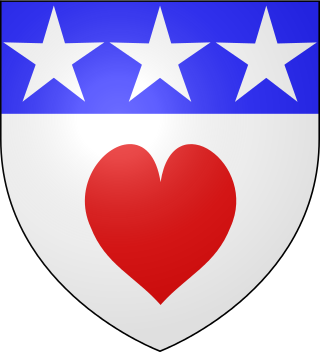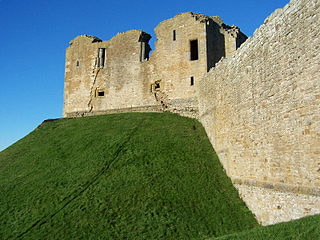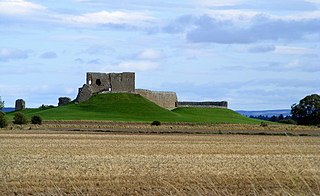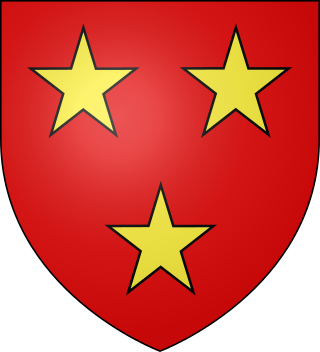
Earl of Sutherland is a title in the Peerage of Scotland. It was created circa 1230 for William de Moravia and is the premier earldom in the Peerage of Scotland. The earl or countess of Sutherland is also the chief of Clan Sutherland.

This page is concerned with the holders of the forfeit title Earl of Douglas and the preceding feudal barons of Douglas, South Lanarkshire. The title was created in the Peerage of Scotland in 1358 for William Douglas, 1st Earl of Douglas, son of Sir Archibald Douglas, Guardian of Scotland. The Earldom was forfeited by James Douglas, 9th Earl of Douglas, in 1455.

Clan Sutherland also known as House of Sutherland is a Highland Scottish clan whose traditional territory is the shire of Sutherland in the far north of Scotland. The chief of the clan was also the powerful Earl of Sutherland, however in the early 16th century this title passed through marriage to a younger son of the chief of Clan Gordon. The current chief is Alistair Sutherland who holds the title Earl of Sutherland.

Clan Murray is a Highland Scottish clan. The chief of the Clan Murray holds the title of Duke of Atholl. Their ancestors were the Morays of Bothwell who established the family in Scotland in the 12th century. In the 16th century, descendants of the Morays of Bothwell, the Murrays of Tullibardine, secured the chiefship of the clan and were created Earls of Tullibardine in 1606. The first Earl of Tullibardine married the heiress to the Stewart earldom of Atholl and Atholl therefore became a Murray earldom in 1626. The Murray Earl of Atholl was created Marquess of Atholl in 1676 and in 1703 it became a dukedom. The marquess of Tullibardine title has continued as a subsidiary title, being bestowed on elder sons of the chief until they succeed him as Duke of Atholl.

Duffus is a village and parish in Moray, Scotland.
Gilbert de Moravia, later known as Saint Gilbert of Dornoch, or Gilbert of Caithness, was the most famous Bishop of Caithness and founder of Dornoch Cathedral. His name may suggest that he came from the semi-Gaelicized family of Flemish origin who were Lords of Duffus, and who during Gilbert's episcopate would create the Earldom of Sutherland under Gilbert's possible cousin, William de Moravia, 1st Earl of Sutherland.

Andreas de Moravia was a 13th-century Scottish bishop. He was a younger son of Hugh de Moravia, from the family of Flemish origin who were lords of Duffus and other areas in the Greater Moray region in this period. In the time of Bishop Bricius' episcopate (1203–1222), there was a man called "Andreas" who was rector of the church of St. Peter at Duffus, and this may well have been this Andreas. He may also have been a native Scot.

Duffus Castle, near Elgin, Moray, Scotland, was a motte-and-bailey castle and was in use from c. 1140 to 1705. During its occupation it underwent many alterations. The most fundamental was the destruction of the original wooden structure and its replacement with one of stone. At the time of its establishment, it was one of the most secure fortifications in Scotland. At the death of the 2nd Lord Duffus in 1705, the castle had become totally unsuitable as a dwelling and so was abandoned.

Freskin was a Flemish nobleman who settled in Scotland during the reign of King David I, becoming the progenitor of the Murray and Sutherland families, and possibly others.

The title Lord Duffus was created by Charles II in the Peerage of Scotland on 8 December 1650 for Alexander Sutherland. He was a descendant of the 4th Earl of Sutherland, who fell in battle in 1333. The title is now extinct, although there may be male-line Sutherlands descended from earlier lairds of Duffus.
William of Douglas was a medieval nobleman living in Clydesdale, an area under the control of the King of the Scots.
The Murrays of Aberscross were a minor noble Scottish family who were seated at Aberscross Castle, in the county of Sutherland, Scotland. The Murrays in Sutherland are recorded specifically as a clan in two acts of the Scottish Parliament of the 16th century.
Sir Reginald le Chen or Cheyne (c.1235–1312) was a 13th-14th century Scottish noble. He was a sheriff of Nairn, sheriff of Inverness and Baron of Inverugie.
Sir Francis le Chen or Cheyne of Straloch was a 14th-century Scottish noble.

Richard de Moravia or Richard de Moray of Culbin or of Cubyn, was a Scottish nobleman famed for his victory over the Vikings at the Battle of Embo which took place in Sutherland, Scotland in 1245.
Freskin de Moray, Lord of Duffus and Strathbrock, was a Scottish noble.
William de Moravia, Lord of Petty, Bracholy, Boharm and Arteldol, was a Scottish noble.

William de Moravia was a Scottish nobleman, Earl of Sutherland and chief of the Clan Sutherland, a Scottish clan of the Scottish Highlands.

Hugh de Moravia, Lord of Duffus, Strathbrock and Sutherland, was a Scottish noble.
Walter de Moravia, Lord of Duffus, and Strathbrock, was a Scottish noble.











